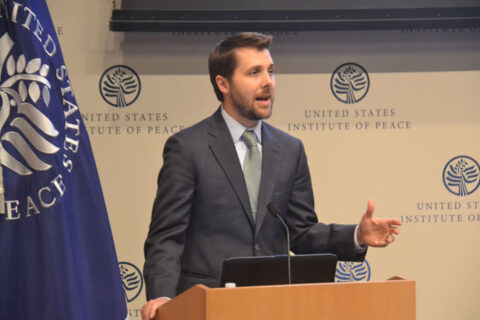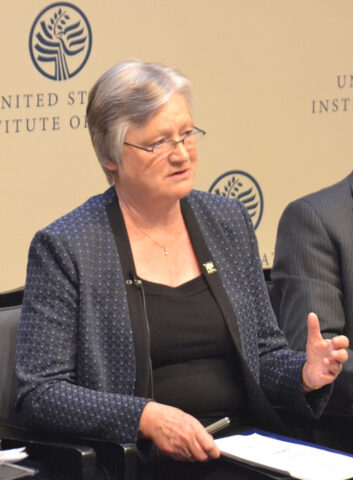A new international public-private partnership promises to provide developing nations with data, information, tools, and training to help them become more resilient to climate change. That assistance could help developing nations better prepare for floods, droughts, sea level rise, and other issues.
The Climate Services for Resilient Development partnership, announced by the White House on 9 June, launched with a commitment of $34 million in financial and in-kind contributions from the United States, United Kingdom, two international development banks, and several nongovernmental organizations and businesses.
The partnership “will enable the U.S. government to apply the technologies, scientific expertise, and capacities it has developed under President Barack Obama’s Climate Action Plan to support resilience efforts in developing nations,” according to the White House. The partnership will target services to countries in subregions of Latin America, Africa, and Asia, with an initial focus on Colombia, Ethiopia, and Bangladesh.
Officials Cite Benefits of Climate Resilience Help
The assistance can’t come soon enough, according to officials from those countries who spoke at the launch event.
“We are one of the front line countries” experiencing climate change, said Mohammad Ziauddin, Bangladesh’s ambassador to the United States.
There is “no doubt that improved climate information services would help countries such as Ethiopia in better adapting to the effects of climate change and enhancing [our] resilience.”
“In most cases, we are unable to assess our vulnerability with facts and figures due to a lack of data and the absence of adequate monitoring infrastructure and research. Therefore we need help in collecting climate related data and improving our early warning systems for flood and drought.” He added, “We also need help in increasing our capacity and expertise for generating more localized information to strengthen resilience of our local communities against climate change.”
Girma Birru Geda, Ethiopia’s ambassador to the United States, said that there is “no doubt that improved climate information services would help countries such as Ethiopia in better adapting to the effects of climate change and enhancing [our] resilience.”
Pablo Vieira, Colombia’s vice minister of environment, added that the benefit of early warning services can far outweigh the required upfront investments.
Commitment to Climate Resilience
Included in the U.S. commitment to the partnership is $10 million in financial support from the U.S. Agency for International Development (USAID) for regional, country, and end user needs assessments and to implement activities and products to help developing nations strengthen their climate resilience; high-resolution elevation data from the U.S. Geological Survey through its Earth Explorer website; and the leveraging of ongoing governmental efforts, such as the National Oceanic and Atmospheric Administration’s International Research and Applications Project, as well as SERVIR, an initiative that involves key support from NASA and USAID in assisting developing nations with satellite-based Earth observation data and science applications. SERVIR comes from the Spanish acronym for the Regional Visualization and Monitoring System for Mesoamerica.
The United States “is deeply committed to helping the poorest and most vulnerable nations become more resilient to the growing impacts of climate change.”
The United States “is deeply committed to helping the poorest and most vulnerable nations become more resilient to the growing impacts of climate change,” John Holdren, assistant to the president for science and technology, said at the launch of the partnership.
U.S. science and technology agencies “can provide as global public goods useful climate data tools and models to decision makers in other nations just as they provide them to U.S. citizens, businesses, farmers, and planners,” Holdren said. “We can think of these products as climate services much like we think of weather services to allow individuals and decision makers to be better informed about what is coming.”
Roots of the Partnership

“The partnership is a key component of the president’s broader vision” about how to deal with climate change, explained Brian Deese, senior adviser to the president for climate change and other issues. President Barack Obama highlighted the need for the partnership in comments he made at the September 2014 Climate Summit at the United Nations and in an executive order.
“You have our commitment that the United States will continue to use every tool that we have available to us to help try to tackle this [climate change] challenge head on,” Deese said. “We will look to build partnerships wherever we can constructively do so.” He added that the plan is for the partnership to grow over the next couple of months with more countries participating. Moreover, the president’s trip to Africa in July is “a specific opportunity to deepen the impact of this partnership.”
USAID acting administrator Ambassador Alfonso Lenhardt said that “climate-resilient development is essential to [the agency’s] goal to end poverty around the world.” He said that “through lessons learned from the scale-up of these efforts, we will help tens of millions of people who are vulnerable to the impacts of climate change by the end of 2016.”
NASA Data Set
Beyond the partnership, but timed with its launch, NASA released a new data set that provides downscaled climate model outputs for every country in the world. The Earth Exchange Global Daily Downscaled Projections data set shows how temperature and rainfall patterns worldwide may change through the year 2100 because of growing concentrations of greenhouse gases in Earth’s atmosphere, explained NASA chief scientist Ellen Stofan.
Additional Support for the Partnership
The United Kingdom’s Department for International Development and the UK Met Office also are partners in the initiative. Dame Julia Slingo, chief scientist with the UK Met Office, told Eos, “My science of weather and climate science has always been about saving lives and livelihoods, protecting infrastructure, helping people to be better prepared, more resilient. And what’s so great here is that this [partnership] is, I think, a germ of a new way of doing that, in a public and private partnership and using the private sector to open a lot of doors that we can’t normally reach.”
Other commitments to the partnership include support for the dissemination of climate services and products from the Inter-American Development Bank and the Asian Development Bank. “The information and data that are available through this partnership is unbelievable,” Samuel Tumiwa, deputy representative of the North American Representative Office of the Asian Development Bank, told Eos. “The real question is how do we get it out to the users.” He suggested pushing information—including early storm warning messages—out to end users through cell phones.
Additional founding partners include the American Red Cross, Esri, Google, and the Skoll Global Threats Fund.
—Randy Showstack, Staff Writer
Showstack, R. (2015), Initiative to assist developing nations with climate resilience, Eos, 96, doi:10.1029/2015EO031387. Published on 12 June 2015.
Text © 2015. The authors. CC BY-NC 3.0
Except where otherwise noted, images are subject to copyright. Any reuse without express permission from the copyright owner is prohibited.


